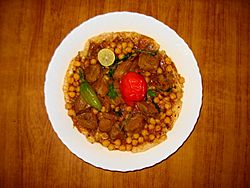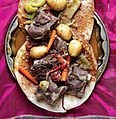Tharid facts for kids

Tharid
|
|
| Alternative names | Tharid |
|---|---|
| Type | Stew |
| Course | Main course |
| Place of origin | Arabian Peninsula |
| Region or state | North-Africa, Middle-East and Southeast Asia |
| Serving temperature | Main dish |
| Main ingredients | Bread, vegetable or meat broth |
Tharid (Arabic: ثريد, also known as trid, taghrib, tashreeb or thareed)(Turkish: Tirit) is a traditional Arab and Turkish dish made from pieces of bread in a vegetable or meat broth. It is especially consumed in the holy month of Ramadan and is quite popular in Arabia.
Contents
Origin
The dish belongs to Arabian cultures. The dish is notable in that it was mentioned in a number of hadith attributed to the Islamic prophet Muhammad, in which he said that tharid was the best among all dishes, and that it was superior to other dishes in the way that Aishah was superior to other women.
Spread
Tharid is not only widespread in the Arabian Peninsula, but also in North Africa, where it is known as trid, and even in Xinjiang, where it is known as terit. Multiple variations of the recipe were brought to Spain by the Moors. The Moroccan rfissa is created by layering cooked meat between paper-thin layers of pastry dough (warqa). In Syria, a similar dish named fatteh is made by a mix of roasted and minced flatbread with yogurt and cooked meat. In Indonesia, tharid is known via Malay cuisine, due to Arab influences on Malay culinary culture.
Consumption
Dipping the bread into the broth, and eating it with the meat is the simplest method of eating tharid. Another variation involves stacking the bread and the meat in several layers.
Gallery
See also
 In Spanish: Tharid para niños
In Spanish: Tharid para niños



